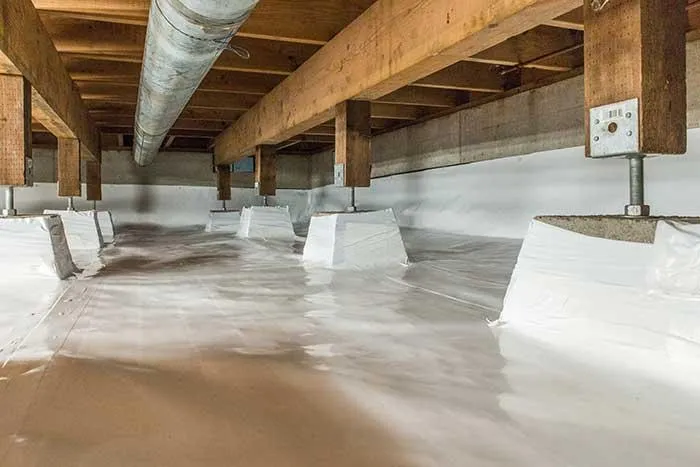
Water in the Crawl Space? Here's What to Do First

By Montclair Construction — Serving Oakland, CA, and the Greater Bay Area with Quality Construction Services Since 1983
Understanding the Problem: Why Water in the Crawl Space Is Dangerous
Finding water in your crawl space is one of those discoveries that homeowners often overlook — until it becomes a costly problem.
A damp or flooded crawl space can lead to mold growth, wood rot, structural weakening, pest infestations, and poor indoor air quality. Since air from your crawl space naturally moves upward into your living areas, moisture problems below can affect the comfort and health of your entire home.
If left untreated, water intrusion can:
Weaken your home’s foundation and framing.
Cause insulation damage, making your home less energy-efficient.
Create a perfect environment for mold spores and musty odors.
Invite termites, rodents, and insects seeking moisture.
Before panic sets in, take a breath — and follow these crucial first steps.
Step 1: Identify the Source of the Water
Every solution starts with proper diagnosis. Crawl space flooding usually comes from one (or a combination) of the following sources:
Surface Water Drainage Issues
Improper surface drainage is one of the leading causes of crawl space flooding. When water isn’t directed away from your foundation, it naturally finds its way underneath your home.
Common problems include:
Poor yard grading — when the soil slopes toward the house instead of away from it.
Clogged or missing gutters that cause roof runoff to spill directly along the foundation walls.
Short downspouts that discharge water too close to the home instead of several feet away.
Improperly placed landscaping or garden beds that trap water around the base of your foundation.
Plumbing Leaks
Not all crawl space water comes from outside — sometimes it’s from inside your own home. A slow or hidden leak under the house can gradually create serious moisture problems.
Look out for:
Leaking water supply lines or cracked drain pipes below your home.
Condensation on cold water lines, especially in humid weather.
Corroded fittings and joints that drip slowly over time.
Old or poorly insulated plumbing that’s vulnerable to wear or freezing.
These issues often go unnoticed until you see signs of damp soil, dripping sounds, or musty odors.
Groundwater Seepage
When the ground becomes saturated after heavy rainfall, rising groundwater can push through your crawl space floor or foundation walls.
Watch for:
Water stains or wet patches along the foundation or footing lines.
Hydrostatic pressure cracks, where moisture seeps through small openings in concrete.
Seasonal flooding that occurs during the wet months or after storms.
Homes built on low-lying areas or clay-heavy soil, which retain water longer.
This type of water intrusion often requires drainage systems or sump pump installation to manage effectively.
Humidity and Condensation
Even without visible leaks or flooding, moisture can still appear due to humidity differences. Warm outdoor air entering a cooler crawl space condenses into water droplets — a silent but damaging problem.
You’ll often notice:
Damp wood beams or metal ducts with small water droplets forming on the surface.
Musty odors or mildew growth on insulation and flooring.
High indoor humidity levels that affect comfort and air quality.
Unsealed crawl space vents that allow humid air to circulate freely.
Over time, this trapped moisture can fuel mold growth and wood rot — even if your crawl space never “floods.”
By understanding the root cause, you’ll know whether you need plumbing repair, drainage correction, or waterproofing solutions.
Step 2: Prioritize Safety Before Entering
Before stepping into a wet crawl space, take precautions.
If there’s standing water, do not enter until the power is shut off in that area. Water conducts electricity, and even a minor exposure can be life-threatening.
If possible, shine a flashlight through the access hatch and visually inspect the extent of the damage first.
If you see deep water or sagging materials — call a professional immediately.
Step 3: Remove Standing Water and Moisture
Once it’s safe, your next step is to get the water out and start drying the area.
Here’s how professionals handle it:
• Pump Out Water: A submersible pump removes standing water quickly.
• Dry the Air: Industrial fans and dehumidifiers are used to eliminate excess moisture.
• Discard Damaged Materials: Wet insulation, wood debris, and any moldy material must be safely removed.
For minor issues, homeowners can rent fans and dehumidifiers. But if you’re dealing with significant flooding or contamination, it’s worth hiring an expert for water mitigation and mold prevention.
Step 4: Repair and Restore the Area
Once the crawl space is dry, the next step is to repair and protect.
This is where long-term prevention comes in:
• Install a Vapor Barrier
A heavy-duty plastic or reinforced liner (often called an encapsulation barrier) prevents ground moisture from evaporating into the space.
• Add a Sump Pump
A sump pump automatically removes any future water that enters the crawl space — perfect for properties in flood-prone areas.
• Improve Grading and Drainage
The soil around your home should slope at least 6 inches downward for every 10 feet away from the foundation to direct rainwater outward.
• Seal Foundation Cracks
Fill or patch any visible gaps where water can seep through walls or floor joints.
• Insulate and Ventilate Properly
Insulation should be moisture-resistant, and ventilation should be controlled to prevent humidity buildup without introducing outdoor moisture.
Step 5: Prevent Future Water Intrusion
Even after solving the immediate issue, proactive maintenance will save you thousands later.
Here are some expert recommendations from Montclair Construction:
• Clean gutters and downspouts twice a year.
• Extend downspout discharge lines at least 4–6 feet from your home.
• Check for plumbing leaks in crawl space pipes annually.
• Inspect your vapor barrier regularly for tears or displacement.
• Consider crawl space encapsulation — the ultimate long-term solution for moisture control and energy efficiency.
Encapsulation transforms your crawl space into a sealed, dry, and insulated area, protecting your home’s structure while improving indoor air quality.
Step 6: Work With Professionals You Can Trust
Crawl space problems require more than a quick fix — they demand experience, precision, and an understanding of local soil and weather conditions.
That’s where Montclair Construction comes in.
With over 40 years of experience, we’ve built a solid reputation throughout Oakland and the Greater Bay Area for delivering high-quality construction, foundation repair, waterproofing, and remodeling services.
Our expert team will:
• Inspect and identify the true source of your water problem
• Provide tailored waterproofing and drainage solutions
• Restore your crawl space to a clean, dry, and secure condition
We’re not just fixing homes — we’re protecting your investment and ensuring your family’s comfort and safety.
Final Thoughts
Water in your crawl space isn’t just an inconvenience — it’s a signal that your home needs attention.
Addressing it early can prevent structural damage, mold growth, and costly repairs down the road.
So when you notice dampness, puddles, or musty odors under your home, don’t wait.
Reach out to Montclair Construction, your trusted local expert since 1983, serving Oakland, CA, and the Greater Bay Area.
Protect your home. Preserve your foundation. Partner with Montclair Construction.
📞 Call us today to schedule an inspection or consultation.
Get a Professional Drainage Evaluation Today
Whether you’re noticing standing water, soil erosion, or foundation cracks, it’s time to take action before the next rainy season hits.
Contact Montclair Construction today for a professional site evaluation and expert recommendation.
We proudly serve Oakland, CA, and the Greater Bay Area, providing trusted construction services since 1983.
